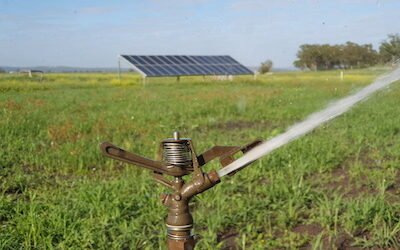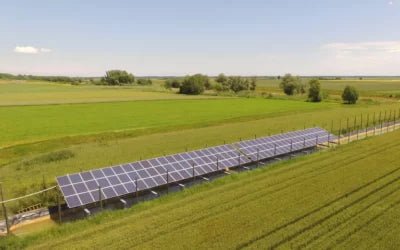Solar water pumps are an efficient way to irrigate your crops and provide accessible water for livestock, especially in areas without access to electricity. They are the most environmentally friendly pump on the market and ideal for any agricultural operation, large or small.
Since solar pumps harness the power of the sunlight to operate, they generate clean, renewable and cost-free energy. For this reason, many farmers are switching from old traditional power sources like diesel and grid electricity to solar water pumps.
Let’s take a deeper look into how they actually work.

How a Solar Water Pump works
A solar pump is generally composed of three parts: the solar panels, the controller and switches, and the pump.
Solar energy is harnessed by the solar panels. This process happens when solar cells, also known as photovoltaic cells, convert sunlight directly into electricity. Photovoltaics (PV) gets its name from the process of converting light (photons) to electricity (voltage), which is called the photovoltaic effect.
The energy then travels to the control unit. The control unit makes sure the machine runs smoothly and keeps the voltage consistent. Next, the unit directs power to the pump’s motor. Typically, there are automated switches which signal whether or not water is needed and turn the pump on and off accordingly.
The pump is either submerged in or set up by a body of water, be it a bore, dam or river. It feeds water into attached pipes which deposit it into a storage tank.
In that regard, let’s take a look at the different types of solar water pumps common in the market.
Types of Solar Water Pumps
There are two main types of water pumps to choose from. Your choice of which type of pump to use could depend on the water source, among other factors. Be sure to consider these options before choosing your solar water pump system.
Submersible Pumps
This is a type of pump that’s waterproof because the components are tightly sealed. Therefore, they can be submerged in the water of your source. All of the electrical connections are waterproof and are submergible as well.
There are two common types of submersible pumps. Let’s take a look at them, so you’ll get an idea of which type you might need or prefer.
1. Helical Rotor Submersible Pump
The HR helical rotor pumps are a positive displacement pump, the rotor has an eccentric movement which when rotating inside the stator effectively squeezes water through the pump on every rotation. This positive displacement action means that water is pumped when the pump is running at very low speeds and that high pressure can be created making it able to pump water at high lifts.
2. Centrifugal Submersible Pump
A submersible centrifugal pump uses spinning impellers to move water using centrifugal forces. Multiple impellers (stages) are added to increase pressure and create required lift. Unlike helical rotor pumps, centrifugal pumps require a minimum speed to pump water. This speed will vary depending on the application e.g. how far and how high the pump needs to push the water.
Surface Pumps
The other type of solar water pump is the Surface Pump. Unlike submersible pumps, surface pumps are not waterproof. These units should be placed in a waterproof pump pit or pump house. However, if they are placed too high above the water level, the pump can have suction problems. This will make the system ineffective or even damage the pump.
The Benefits of a Solar Pump
Key takeaways:
- Solar pumps are extremely reliable, requiring little maintenance. They’re ideal in remote or off-grid areas, as they are a completely self-sufficient system, generating and operating off their own power source.
- They are particularly useful to farmers, especially those with creeks or dams on their properties. Supporting healthier water systems, they prevent contamination and slow down erosion of banks.
- It also means that they can provide water to livestock from multiple locations.
1. Built for High-Performance in Dry Regions
As water scarcity and severe droughts have become an ongoing problem in many regions over the past years, more and more farmers are going towards solar solutions to fulfill their energy requirements.
Smallholder farmers have found a safe spot through the use of solar-powered water pumps. Such equipment is advantageous to use for agriculture in arid regions like Australia because it requires minimum water delivery to crops.
While you can obviously use diesel in dry regions as well, think about the logistics of transporting fossil fuel products to remote or rural farming communities. Solar energy is a cheaper and more sustainable alternative to diesel. Farms using solar power reduce the risk of running out of supply, as the sun is a free and renewable resource. These farms are often located in places where diesel would be too expensive to deliver, or they are places where it is too difficult to transport diesel through pipelines. In most cases solar farms can be built where extra land is available, which is usually near the source of produce that needs transporting.
Also, unlike diesel, solar water pumps are specifically designed to use in sun-drenched areas of the world. In dry regions like Australia, the sun is the fuel itself.
2. Environmentally Friendly
With the global population continuing to increase and climate change becoming an increasingly critical issue, the need for sustainable agricultural solutions is more pressing than ever. For farmers, this is a worrying trend that affects them more than others. Not only do they have more people to feed, but erratic climate phenomena will wreak havoc on their livelihood as well, which in turn affects the whole world.
Fortunately, solar energy reduces the carbon footprint that farmers themselves contribute. That is why it has become crucial to invest in sustainable and renewable energy sources such as solar power. This type of alternative energy can not only cut down on costs, but also provide farmers with a way to support themselves through the uncertainties of farming in the face of climate change.
3. Cost-Effective
The best benefit of solar energy and why more Australian farmers are choosing it is that it’s a cost-effective source of energy. There is no doubt that solar energy is the cheapest source of power in the world. It will save farmers a lot of money on electric bills because they won’t have to rely on the electric grid or costly diesel prices.
Why pay for expensive diesel when you can use the free energy projected by the sun?
4. Versatile Power Sources (aka Hybrid or Blended Power)
The great thing about solar powered water pumps and other agriculture machines is that they are versatile. For instance, there are many solar water pumps like the LORENTZ PSk3 that feature hybrid technology that blends various power sources: solar energy via solar panels and battery packs; traditional electric grid; gas-powered generators, and other types of power sources.
In comparison, exclusively diesel-fueled agri-machinery are one-dimensional and limits your capabilities. The versatility of solar water pumps also allows you to control usage and adjust which power source to use to match your monthly/yearly budget.
5. Portability
Traditional water pumps that use diesel and other fossil fuel tend to be heavy and bulky units. Meanwhile, water pumps that rely on the electric grid are limited in mobility, even if you have long extension cords (which reduce power the longer they are). These types of old water pumping units are a hassle to move around.
On the other hand, you can carry solar water pump systems to the site of operation and install them easily. The other advantage of portable solar power systems is that you can store them easily when not needed, or if severe weather threatens to damage your equipment.
The evolution of solar technology is rapidly evolving and as a nation, we have an increased focus on moving to renewables so we can expect new regulation to be introduced that incentives clean energy. With this in mind, there has never been a better time to move to a sustainable solution to water your crops or livestock than solar energy. To find out more about what solar pump will work best for your agricultural business, get in touch and we will connect you with an expert to work out the best solution for your requirements.







